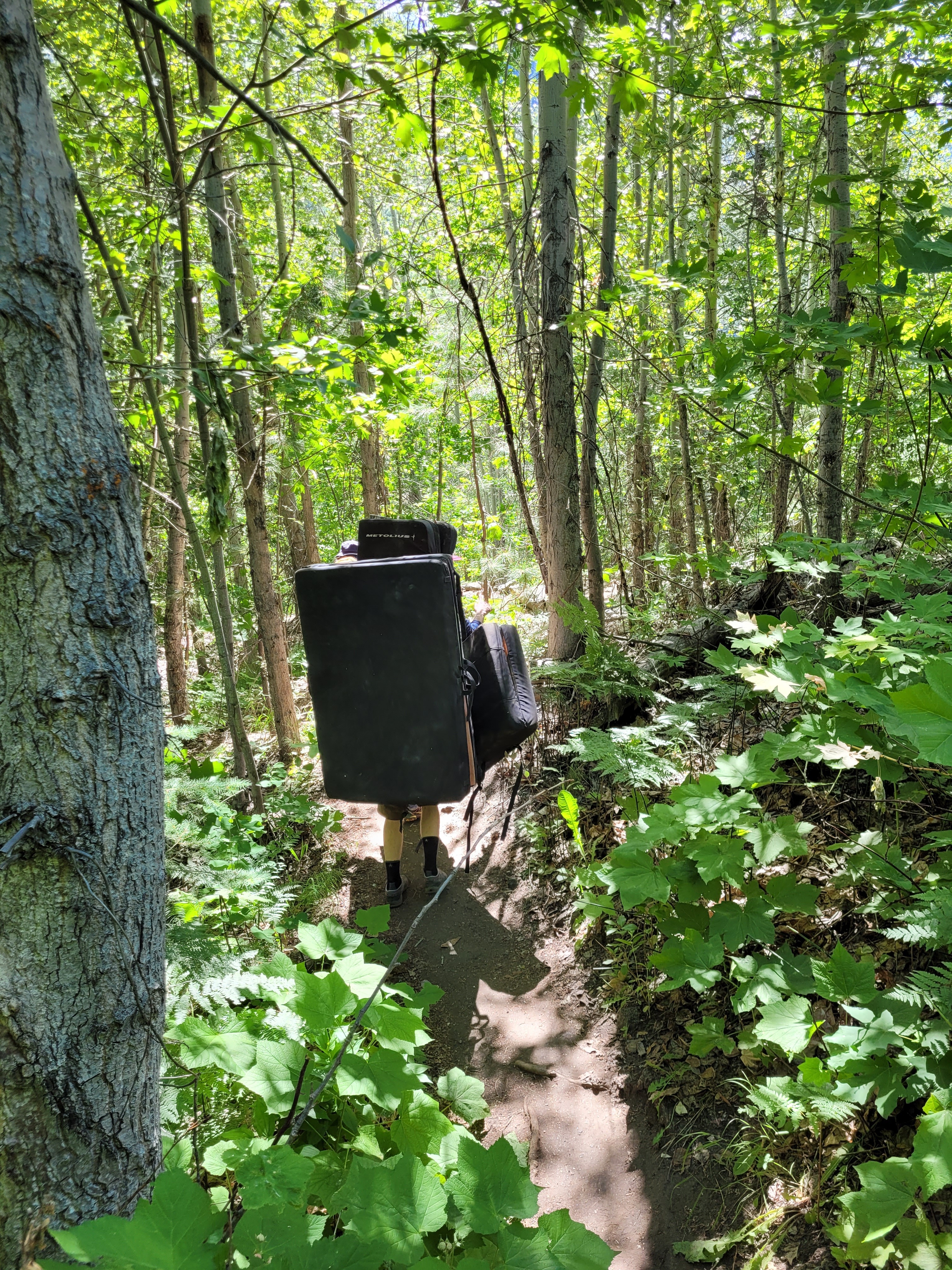Wild Country Revo Belay Device
Add heightened security to your belays with the Wild Country Revo belay device. Its function is independent from the loading orientation of the rope, eliminating a common cause of accidents.




This purchase pays for membership!
$14
10% Reward
on this and every eligible full-price item*
+
$30
Bonus Card
valid for 60 days after joining*
=
$44
Value
Keep shopping
- An uncontrolled descent automatically activates the inertia reel to grip the rope and arrest the fall
- Innovative, panic-proof locking mechanism removes the need for a handle to unlock the system when lowering the climber
- Bidirectional locking function works regardless of the rope orientation
- Revo is intuitive to use like a traditional belay plate and is well-suited for both novice and expert belayers
- Ascent Lite Belay carabiner sold separately
Imported.
View all Wild Country Belay and Rappel Devices| Best Use | Rock Climbing |
|---|---|
| Assisted Braking | Yes |
| Suitable for Belaying | Yes |
| Suitable for Rappelling | Yes |
| Fits Rope Sizes | 8.5 - 11 millimeters |
| Weight | 245 grams |
Review this Product
Adding a review will require a valid email for verification
Most Helpful Favorable Review
Most Helpful Critical Review
Great for adding security when being belayed
I am a climbing guide on the Front Range of Colorado and I have been using the Revo for it's added security when I have a beginner belaying me. When I teach beginners how to give me a lead belay, it is much easier teaching them how to feed slack and lower me on a Revo than another device like an ABD, aside from a tube-style device. The added benefit to the Revo over the tube-style device is that if my belayer lets go of the brake hand then the locking mechanism stops rope from sliding through the device. I will forever bring one in my bag for single-pitch guiding.
What a wonderful piece of equipment!!!
I think the Revo is so easy to use. Pays out extremely well, and if you catch someone correctly it doesn’t need to engage. But if something goes wrong, it completely locks. The grigri is now in the bottom of my bag and I use the Revo exclusively. There aren’t really cons to this device, just a learning curve. Now I’ll get into that. I thought the grigri had a pretty decent learning curve until it became second nature to use. With the Revo, there are two things to learn. Since it locks in both directions, if you take really fast it locks up, and all you have to do is pay a couple inches in the other direction and you’re good. And if you lower someone too fast it breaks. The Revo essentially makes you learn to belay smooth. I love this device. I hope they come out with a guide version one day to belay from above. Cheers
A great device
After 21 years of climbing this is quickly becoming my favorite cragging belay device. Most importantly, it belays with the same technique that is used for an ATC/tuber device. Paying out or taking in slack is exceptionally smooth - more so than any device I have ever used, even with thick ropes. When braking the jaws bite solidly even on skinny ropes. In the event that one does not brake when the climber falls, the assisted lock activates cleanly. Unlocking the device in this case is as simple as putting the brake strand back into locked off position and tugging down a bit. Lowering is easy. Just put both hands on the brake and lower as you would with an ATC/tuber. Again the assisted lock engages if you lose control. Again this can be released by putting the brake strand back to brake position and tugging down a bit. Because the device is used like an ATC/tuber it is not great for a lot of hang dogging - the lock assist does not activate simply by taking, so there is no opportunity for the belayer to relax his or her grip. In this situation a Grigri is a bit easier. Overall a superb device.
Kids' favorite belay device
We have now put the Revo through its paces on about 15 climbing days, used by seven different belayers. I wanted to write up a little review that focuses on our target use: kids lead belaying. TL;DR: our kids fight for the Revo, not only when belaying, but also when being belayed. The partners with lowest priority get the Grigri 2. :) But the adults still prefer the Grigri 2 when belaying a leader working a route. The major consideration here is that our kids simply cannot reliably pay out slack on the Grigri 2. With our 12-year-old, we are talking months of practice on dozens and dozens of belays, trying at least four different methods recommended by others, including the official Petzl method. I think his hands are just too small. The Revo solves that problem. Pros: The Revo is by far the smoothest device for paying out slack that we have used. It never locks up, and a belayer as young as 8 can easily pay out slack quickly to a leader (another kid). Its autolocking feature works flawlessly. Our kids have never dropped anybody accidentally, but in tests the Revo catches a fall on its own without scaring the falling climber (even kids). If a climber is hanging for a long time on a route, you can fairly easily manually lock the Revo to hold their weight. Some kids might have trouble doing this, though. It provides plenty of friction for a mid-sized kid (12 yrs old, 90 lbs) to comfortably hold and lower a full-size adult (160 lbs). It provides plenty of friction for small kids (8-10 yrs old, 60-70 lbs) to comfortably hold and lower kids who weigh about the same as them. It still gives kid belayers a more reliable, more controllable lowering experience compared to the Grigri. Cons: Because the Revo's primary mode is as a friction device and it does not auto-capture progress, it works no better than a tube device for working routes. When I am belaying somebody working a route, even my 12-year-old son, I find the Grigri much more effective. (However, my son still prefers the Revo because he has such trouble paying out slack on the Grigri.) It doesn't provide as much friction as some tube devices and other assisted braking devices. So my 10-year-old daughter has trouble holding my 90-lb son for an extended period of time. Any difficulties with friction because of weight differential can be offset by using an Edelrid Ohm. However, we've decided the Ohm is more trouble than it is worth. Since we usually climb overhanging routes, we were frequently encountering situations where the Ohm made it nearly impossible to feed slack reliably or to lower safely. Fortunately, my son and I now have a reasonable weight differential and don't need it anymore. We will still pack the Ohm for situations when one of the younger kids needs to belay another, larger kid leading a route that offers a workable ropeline for the Ohm. Our kids literally fight over the Revo because it completely eliminates the frustrations they inevitably have with the Revo. They also prefer to be belayed with the Revo when leading, because even their Dad and Mom shortrope them less often than when using the Grigri. ;) So we will still be carrying a Grigri to the crag, but we are in the market for another Revo--let me know if you want to sell your used one! And we're very much hoping the Revo 2 will have assisted progress capture like a Grigri.
Over-Hyped New Release
The Revo is effectively an expensive ATC/tuber with some cool gimmicks. The fact that it locks up if someone is hanging on the rope and you let go is neat, and is a nice safety addition, but the locking mechanism does not engage during lead falls unless slack in the system is gratuitous (meaning unless you're more than three clips up you're going to hit the deck before it catches). Previous reviews stating the device locks up quickly during lead falls if there is slack in the system do not line up with my experience using the Revo and strike me as misleading. The locking mechanism is also too difficult to engage when the rope is already weighted, making resting uncomfortable for the belayer. For practical applications, the above issues mean the assisted break doesn't actually assist when you'd like it to, and does not ease handling for the belayer the way a Grigri or other camming device can. If all you do is top-rope in the gym, this is a great device, but I would not want to use it for any other applications.
Perfect lead device, but needs a better resting me
I switched to the Neox recently, but the Revo is an amazing piece of lead climbing gear and I firmly believe it is the safest belay device in existence. It is entirely failsafe, but it has a mild learning curve and some people don't trust it (the distrust is baseless, but happens anyway). The biggest issue I have with the Revo is that it's almost impossible to lock the device to take a rest when there is tension on it. To lock it without dropping the climber more than an inch or two you have to jump take while locking both brake sides up. It's a skill. Otherwise you just have to hold the climber with your arm like a caveman. Do NOT top rope with the revo unless you forgot your primary belay device and have no alternative. it's exhausting.
Excellent for Leading in the Gym
The Revo does exactly what I had hoped - a very smooth feeding belay device with backup safety of assisted blocking. I've been using an ATC for lead and Grigri 2 for TR work. The Revo replaces the ATC and I've also replaced the G2 with ATC Pilot - another assisted blocker. I bought this with specific sole intention of gym work, living in Atlanta and working means I spend 2 to 3 days a week climbing inside. I haven't used the device outside, I like my ATC for that - it's light and effective + plus rapping. The Revo is heavy if you have a long hike in but for roadside cragging it would be fine. I find the Revo less useful for TR as engaging the auto block can be a bit fiddly compared to G2 or ATC pilot. I have never had the auto block engage on lead falls, the device catches like a tube, friction is enough but 'drops' will lock it up. I have seen a climber dropped in the gym - 60ft is a long way. I have friends who have been dropped. I like the Revo as it nearly eliminates the chance of that scenario while feeding rope more smoothly that the G2.
Brilliant Design. Safe. Easy to let out lead rope.
Perfect for Lead Belay. Not as useful for top rope. Highly recommended for sporty/trad climbing. Quick to learn. Does not work in the same way as a gri gri. It has to be thought of as a totally different device.
Overhyped ATC with a backup system
After using the Revo for an afternoon of indoor sport climbing, I came to the conclusion that this device is a great ATC replacement, but really nothing more, and certainly not worthy of the hype. As an ATC replacement, it feeds slack wonderfully. Unless you yank unreasonably hard, you'll never short-rope some one on lead. If the climber falls, and you're belaying responsibly, it functions exactly like an ATC as well. You'll catch them with your brake hand and you'll hold them there fairly easily. So how is it different from an ATC? First, if you let go of the rope, the Revo will ultimately engage and catch the climber. In my (approximate and unofficial) indoor gym tests, a climber had to fall about 3 clips (from resting at 4 clips up) before the device would catch. Not great right? Second, you can theoretically get the device to lock manually, allowing your brake hand to rest. Supposedly, you do this by yanking up on the brake metal and simultaneously reducing tension in the rope. Good luck with that -- 6 of us tried with only occasional success. In the end, we found that the easiest way to get a manual lock was just to release the climber, with another hand lower down the rope (because the rope is already tense in this case, the device locks almost instantly). I'm not writing to recommend this technique, so much as to point out the lengths we went to to get the device to lock. When I purchased the Revo, I was under the very mistaken impression that the locking system was essentially a better version of the camming mechanism on a Grigri. Maybe I wasn't paying enough attention, but I devoured everything I could find about the device (e.g., the Climbing Magazine award), and a number of my friends were similarly disappointed, so I'm sure we're not alone. In the end, if you want a safer ATC, and/or have money to burn, go ahead and buy this; otherwise, this is your warning.
Excellent for what it is
I used this intensively while climbing and guiding and I enjoyed the benefits of this device but it still is just another tool but does not replace anything on my harness. This is great addition to the world of assisted belay devices as this one is essential a mechanical tube style device. Belay as you would with any other tube device with the added confidence that the Revo will lock if something goes wrong with the belay. It feeds very smoothly but does not provide as much friction when the rope is weighted which makes it a tough device if the climber needs a extra tight belay or if the climber weights the rope often. You can't easily belay off the harness, as you would in a multi pitch terrain, with this device, and due to the lack of bite it is tougher to single line rappel with it as well. It has its place with teaching new belayers how to belay and giving them the freedom of doing it while still having a built in backup. This would make a significantly better addition to a program or climbing gym than a gri-gri. Like a all devices, if it is new to you there is a adjustment period. This one can be quite significant as it has less friction and does not lock like many are used to. I became much more comfortable and used to all the quirks and unique aspects of this after approximately 350 hours of use.




